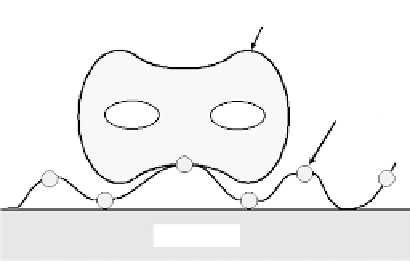Biomedical Engineering Reference
In-Depth Information
Glycoprotein
Electron
Relay
FADH
2
FADH
2
R
R
R
R
R
R
Electrode
FIGURE 3.3
Electrical contacting of a fl avoenzyme by its reconstitution with a relay-FAD semisyn-
thetic cofactor.
Chemical modifi cation of GOx with electron-relay groups represents another novel
avenue for facilitating the electron transfer between its redox center and the electrode
surface. Willner and coworkers [13] reported on an elegant approach for modify-
ing GOx with electron relays. For this purpose, the FAD active center of the enzyme
was removed to allow positioning of an electron-mediating ferrocene unit prior to the
reconstitution of the enzyme. The attachment of electron-transfer relays at the enzyme
periphery has also been considered for yielding short electron-transfer distances [30].
More sophisticated bioelectronic systems for enhancing the electrical response, based
on patterned monolayer or multilayer assemblies and organized enzyme networks on
solid electrodes, have been developed for contacting GOx with the electrode support
[30]. Functionalized alkanethiol modifi ed gold surfaces have been particularly attrac-
tive for such a layer-by-layer (LBL) creation of GOx/mediator networks.
3.5
IN-VITRO
GLUCOSE TESTING
Electrochemical biosensors are well suited for satisfying the needs of personal (home)
glucose testing. The majority of personal blood glucose meters are based on dispos-
able (screen-printed) enzyme electrode test strips [31, 32]. Such single-use disposable
electrode strips are mass produced by the thick fi lm (screen-printing) microfabrication
technology [21, 33]. The screen-printing technology relies on printing patterns of con-
ductor and insulators onto the surface of planar (plastic or ceramic) substrates. Each
strip contains the printed working and reference electrodes (Fig. 3.4, see Plate 1 for
color version), with the working one coated with the necessary reagents (i.e. enzyme,
mediator, stabilizer, linking and binding agents). Such reagents are commonly being
dispensed by inkjet printing technology. A counter and an additional (“baseline”) work-
ing electrode may also be included. Such single-use devices obviate problems of car-
ryover, contamination or drift. Various membranes (mesh) are incorporated into the test
strips, and along with surfactants are used to provide a uniform sample coverage.







Search WWH ::

Custom Search